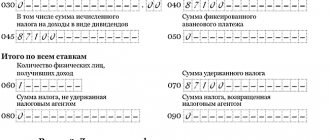Dividends to the founder: accrual and payments
Payment of dividends to shareholders or participants is possible if there is profit for a certain period. The decision on its full or partial distribution between the founders can be made once a year, quarterly, or once every six months. This decision may be made by:
- in the JSC - the General Meeting of Shareholders, taking into account the recommendations of the Board of Directors limiting the amount of “dividend” payments;
- in LLC – General meeting of participants.
If there is only one founder/shareholder of the company, then he does not need to hold a General Meeting - he makes the decision on the payment of dividends by his sole decision.
What part of the net profit is allocated to pay dividends to the founders is determined according to the accounting records for the corresponding period, and the General Meeting may completely leave the profit undistributed and not pay dividends to the founders.
The decision of the General Meeting is documented in minutes, including the following information:
- the period for which dividends are paid (year, half-year, etc.),
- total amount of dividends,
- the amount of income for each type of shares (in JSC),
- the date on which the composition of shareholders receiving dividends must be determined - no earlier than 10 and no later than 20 days from the date of the decision on payment (in the JSC),
- form of payment (money or property),
- dividend payment period.
Dividends are calculated and paid as follows:
- in a joint stock company, dividends can be accrued as a percentage of the par value of the share, or as a fixed amount per share,
- In an LLC, as a rule, dividends are distributed in proportion to the shares of the participants, unless otherwise provided by the charter.
A JSC can pay dividends independently, or through a registrar with whom an agreement has been concluded to maintain a securities register, or through a credit institution. Owners of preferred shares receive their income first, followed by common shares.
The LLC pays dividends to participants independently within the period determined by the decision.
Shareholders/participants can receive “dividend” income to bank accounts, as well as by postal order, or through a cash desk.
Before paying dividends, taxes are withheld from shareholders/participants and transferred to the budget:
- Personal income tax from individuals,
- income tax from legal entities.
Taxes are charged at the rates in effect on the date the dividend is paid.
Concept, content and types of dividend policy
Dividend policy refers to the policy of distributing profits into dividends and the capitalized part (figure).
The further distribution of part of the profit aimed at paying dividends is a mechanism for generating personal income of shareholders in accordance with the size of their participation in the capital of the enterprise. Further distribution of the capitalized part of the profit, depending on the strategic goals of the enterprise, can be aimed at financing both current operations and investments. The goal of dividend policy is to establish the optimal, i.e. such a ratio between dividends (as current consumption of profits) and the capitalized part (as invested with the aim of generating profits in the future), which could:
1) maximize the market value of the enterprise;
2) ensure its strategic development.
Indeed, the investment opportunities of an enterprise depend on the proportions of distribution of net profit into dividends and the capitalized part:
1) the higher the dividends, the lower the investment opportunities of the enterprise;
2) the lower the dividends, the greater the investment opportunities of the enterprise.
Wherein:
1) an increase in dividends paid in the current period reduces not only the investment opportunities of the enterprise, but also future profits and, accordingly, future dividends;
2) a decrease in dividends paid in the current period increases not only the investment opportunities of the enterprise, but also future profits and, accordingly, future dividends (of course, provided that investment projects are not only implemented, but also turn out to be profitable).
It is obvious that decisions on the payment of dividends made in the short term have an impact on the financial condition of the enterprise and, consequently, the welfare of its owners (shareholders) in the long term.
Efficiency of dividend policy:
1) is determined by the compliance of short-term (tactical) decisions with the strategic (long-term) development goals of the enterprise, which is expressed in the optimal distribution of profit into dividends and the capitalized part;
2) depends on smoothing out contradictions in the interests of the enterprise and its nominal owners - shareholders.
As you know, a shareholder’s income from owning a share consists of two elements:
1) income from the increase in market value (the difference between the sale price and the purchase price of the stock);
2) interest income (dividends).
Thus:
1) on the one hand, the welfare of shareholders increases with an increase in the market value of shares (a shareholder, when selling a share that has increased in price, will receive an amount greater than what was previously invested);
2) on the other hand, the welfare of shareholders increases with an increase in the size of dividends (an increase in dividends contributes to an increase in the market value of shares and is a kind of indicator for existing and potential shareholders, indicating the successful activities and good financial condition of the enterprise).
The main contradiction between the interests of shareholders (as owners of the enterprise) and the enterprise itself in the current period is that the payment of dividends:
1) is an influx of cash for shareholders;
2) cash outflow for the enterprise.
Based on this, when developing and implementing a dividend policy, it is necessary to take into account both the interests of shareholders and the interests of the enterprise itself. Shareholders' preferences. Let's pretend that:
1) investors, as owners of an enterprise, perceive decisions on both the payment of dividends and capitalization in the same way;
2) decisions on capitalization with subsequent reinvestment are a priority, and dividends are considered as a passive balance, the payment and value of which depend only on the availability of promising investment projects.
Based on these premises, investor preferences will be distributed as follows:
1) if the forecast level of profitability of investment projects exceeds the average level, investors will give preference to capitalization;
2) if the forecast level of profitability of investment projects is equal to the average level, then the payment of dividends and capitalization are perceived by investors in the same way;
3) if the forecast level of profitability of investment projects is below the average level, then investors will give preference to paying dividends.
Enterprise preferences. As mentioned above, paying dividends means an outflow of cash. Therefore, when developing and implementing a dividend policy, it is necessary to take into account the impact of dividend payments on the financial condition of the enterprise. Based on the financial condition of the enterprise in the current period, it is necessary to decide:
1) is it worth paying dividends at all;
2) if so, then determine their optimal value;
3) determine sources of financing:
— investment decisions, if the payment of dividends significantly reduces the investment capabilities of the enterprise;
— payment of dividends if the company does not have the necessary funds for this.
The main indicators characterizing the dividend policy include the following ratios:
1) dividend per share (Div);
2) net profit per common share (EPS);
3) dividend payments (DPR);
4) capitalization of net profit (b).
1. The dividend per share ratio (Div) is the ratio of the amount of dividends paid and the number of common shares outstanding.
K = Amount of dividends paid / Number of common shares outstanding
Number of common shares outstanding = total number of common shares outstanding - own common shares in the company's portfolio
2. The net profit per share (EPS) ratio is defined as the ratio of net profit minus the amount of dividends on preferred shares and the number of common shares in circulation:
K = Net profit - dividends on preferred shares / Number of common shares outstanding
Number of common shares outstanding = total number of common shares outstanding - own common shares in the company's portfolio
3. Dividend payout ratio (dividend rate) (DPR) represents the share of dividends in net profit:
K = Amount of dividends paid / Net profit - dividends on preferred shares x 100%
4. Net profit capitalization ratio (b)
K = 100% - dividend rate
The method of distributing net profit into dividends and the capitalized part determines the type of dividend policy. Types of dividend policy:
1) a policy of a stable share of dividends in net profit;
2) a policy of stable dividend dynamics;
3) residual dividend policy.
The policy of a stable share (stable share) of dividends in net profit implies that every year the same percentage of the total net profit is allocated for the payment of dividends (table).
A policy of a stable share of dividends in the net profit of an enterprise is acceptable if the enterprise receives stable profits, and unacceptable if the amount of profits from period to period is subject to sharp fluctuations. Calculation of policy indicators for a stable share of dividends
| No. | Dividend policy indicators | Years | ||
| 1 | 2 | 3 | ||
| 1. | Net profit to be distributed | 6000 | 8000 | 10 000 |
| 2. | Number of common shares outstanding | 2000 | 2000 | 2000 |
| 3. | Capitalization | 70% | 70% | 70% |
| 4. | Dividend Rate (DPR) | 30% | 30% | 30% |
| 5. | Total dividend amount | 1800 | 2400 | 3000 |
| 6. | Dividend per common share outstanding (Div) | 0,9 | 1,2 | 1,5 |
A policy of stable dividend dynamics implies achieving moderate growth in dividends per share, capable of compensating for inflation (table).
In this case, the maximum value of the dividend rate (DPR) is 50%. Calculation of indicators for a policy of moderate dividend growth
| № | Dividend policy indicators | Years | ||
| p/p | 1 | 2 | 3 | |
| 1. | Net profit to be distributed | 6000 | 8000 | 10 000 |
| 2. | Number of common shares outstanding | 2000 | 2000 | 2000 |
| 3. | Capitalization | 70% | 65% | 60% |
| 4. | Dividend Rate (DPR) | 30% | 35% | 40% |
| 5. | Total dividend amount | 1800 | 2800 | 4000 |
| 6. | Dividend per common share outstanding (Div) | 0,9 | 1,4 | 2,0 |
Residual dividend policy implies payment of dividends only after financing of investments. The implementation of promising investment projects inspires investor confidence in the enterprise and, accordingly, in the securities issued by the enterprise, the market value of which in this case increases.
Factors influencing dividend policy:
1) external factors, including:
— political and socio-economic stability in the country;
— changes in current legislation, which may determine the order and sequence of payments on securities, limit the increase in interest income, etc.
2) internal factors:
— size of the enterprise (large enterprises are less likely than others to evade paying dividends);
— profitability of the enterprise (highly profitable enterprises are more often required to pay dividends);
— liquidity of the enterprise (if payment of dividends in the current period may lead to a decrease in the liquidity of the enterprise, it is necessary to find additional sources of financing);
— the ratio of equity and borrowed funds (enterprises with large debts prefer to use part of their profits to repay them rather than pay dividends);
— the creditworthiness of the enterprise (determines the possibility of attracting additional sources of financing);
— availability of promising investment projects.
The decision to pay dividends must be made taking into account:
1) the ability to finance such payments;
2) the need to maintain liquidity.
Carrying out a balanced and reasonable dividend policy is impossible without its planning, based on forecasting profits and the level of dividends. The profit forecast is the result of drawing up an annual financial plan. As mentioned above, the annual financial plan includes budgets and forecast reporting forms. Thus, based on the product sales budget and the expense budget, a forecast profit and loss report is compiled, the result of which is a forecast net profit. Based on the forecast net profit, you can obtain a forecast profit per one common share in circulation (excluding or taking into account the new issue). For this:
1) the forecast figure for net profit must be reduced by the amount of possible deductions from net profit (deductions to funds, reserves, for the payment of dividends on preferred shares, etc.);
2) the resulting amount of net profit to be distributed to dividends and the capitalized part must be divided by the number of common shares in circulation (with or without taking into account the new issue).
There are the following methods for predicting dividends.
1. Determination of the target level of dividends based on data on the payment of dividends by analogous enterprises:
Target (acceptable and possible for the enterprise) level of dividends per one common share in circulation = dividend payout ratio characteristic of the most stable operating enterprises in this industry • forecast earnings per share
2. Determination of the expected dividend level as an exponentially weighted average between the previous year’s dividend and the target dividend level of the current year:
Expected dividend level = adjustment factor x target dividend level + (1 - adjustment factor) x last year's dividend
The adjustment coefficient is intended to smooth out the dynamics of dividends over the years. It is selected in such a way as to minimize the forecast error in previous periods. The level of dividends at each point in time is equal to the product of earnings per share and the dividend rate:
Adjustment factor = earnings per share outstanding (EPS) x dividend rate (DPR) - previous period dividend (Div t -1 ) / current period dividend (Div) - previous period dividend (Div t -1 )
Analysis of dividend dynamics reveals the following patterns:
1) when profits increase, their growth rate is higher than the dividend growth rate;
2) when profits decrease, the rate of their decrease is lower than the rate of decrease in dividends.
Restrictions on dividend payments
The Law on LLC (Article 29) and the Law on JSC (Article 43) contain a number of conditions under which the company does not have the right to pay dividends until these circumstances are eliminated:
- the authorized capital has not been paid in part or in full;
- the value of the share of the retired participant (in the LLC) has not been paid,
- the amount of net assets does not exceed the sum of the authorized capital and reserve fund. In JSC, in addition to this, the amount of excess of the value of preferred shares over their par value is taken into account;
- the order of decision-making on dividends on preferred and ordinary shares (in JSC) is violated;
- the company has signs of bankruptcy on the day the decision is made, or they will appear as a result of paying dividends.
Dividend payment period
In a JSC, the timing of dividend payments is calculated from the date on which the composition of shareholders is determined. These deadlines should not exceed (Clause 6, Article 42 of Law No. 208-FZ):
- 10 working days – for payments to nominal holders of shares and trustees-professional participants in the securities market;
- 25 working days – for other shareholders of the JSC.
In LLCs, the timing of dividend payments in 2021 is still limited to 60 days (Clause 3, Article 28 of Law No. 14-FZ). This is the maximum time during which participants must receive the dividends due to them, but the charter of the company or the General Meeting of Participants may establish a shorter period for payments. When a specific period is not specified, it is considered to be 60 days.
In case of violation of the dividend payment schedule of a JSC or LLC (for example, due to the company not having the correct payment details of the founder), participants who have not received their income within the established time frame have the right to claim it from the company within 3 years, or 5 years, if longer the period is specified in the charter. The countdown of the claim period begins: in a JSC - from the day the decision to pay dividends is made, and in an LLC - after 60 days allotted for payment (clause 9, article 42 of Law No. 208-FZ; clause 4, Article 28 of Law No. 14 -FZ).
If, before the end of the specified period for receiving dividends, they remain unclaimed, the company again includes them in its profits, and the right to claim is lost.
How is the decision to pay dividends to an LLC made?
Accruing and paying dividends to all founders or participants of an LLC is a right, not an obligation, which is enshrined in the charter document. According to the generally accepted rule, the distribution of dividends from an LLC is made in proportion to the shares invested in its authorized capital (clause 2 of Article 28 of the LLC Law).
All answers to questions regarding the distribution of the company’s net final profit are contained in the documents:
- Charter provisions;
- Corporate agreement between all participants;
- Provision on profit distribution (internal).
The law does not prohibit making changes to documents and paying dividends disproportionate to the invested capital of participants. In practice, there are many situations when such a corporate agreement is revised and new persons are added to it who have the right to receive a part of the final profit. The main condition is to hold a general meeting to make appropriate additions to the agreement with the unanimous approval of all LLC participants. In this case, you can limit yourself to changing the corporate agreement without revising the charter (Civil Code of the Russian Federation, Art. 66.1 and Art. 67.2).
It is legally established that all potential participants must be notified of the meeting 30 days before it takes place. Payment will be made to all persons indicated in the register, regardless of their presence at the meeting.
All issues related to the amount and timing of payment of dividends are resolved only at a general meeting with the participation of the founders of the company (Law on LLC, clause 7, clause 2, article 33). This important function cannot be taken over by another organization (as well as putting pressure on the management of the company in the distribution of income).
To discuss and make a decision on the possibility of paying dividends:
- A general meeting is held at which financial documentation and accounting reports are presented;
- The share of income received for the payment of dividends to LLC participants is determined, and a decision is made on the procedure for distributing this amount;
- A collective decision is made on the timing and form of payments based on a mathematical majority from among the company participants present.
After the meeting, based on the signed minutes, the management of the LLC must issue an appropriate order.
Reflection of dividend payments in financial statements
Dividends are accrued in accounting on the basis of a payment order, which must contain information about the persons receiving dividends, the amounts to be accrued, and the timing of payment.
Which accounting entry means the accrual of dividends to shareholders or members of the company? This operation is formalized by the following transactions:
| Posting date | Wiring | Decoding |
| Payment decision date | Dt 84 Kt 75(70) | The shareholder/participant was accrued dividends in accordance with the payment order. Account 70 is used if the shareholder/participant is also an employee of the company |
| Date of actual payment | Dt 75(70) Kt 68 | Profit tax or personal income tax is withheld from dividends |
| Date of actual payment | Dt 75 Kt 51(50) | Dividends are transferred to the shareholder/participant |
| Date of transfer to the budget | Dt 68 Kt 51 | Tax on dividends paid is transferred to the budget |
How to reflect the payment of dividends in the company’s financial statements:
- “Balance Sheet” - payment of dividends in the balance sheet is reflected in line 1370 “Retained earnings”, or rather, their amount is subtracted from this indicator.
- The payment of dividends is not reflected in the Financial Results Report.
- In the “Report on Changes in Capital” line 3327 is provided for dividends. This form does not need to be filled out by those who submit simplified accounting reports.
In addition, tax reporting for personal income tax (forms 2-NDFL, 6-NDFL) and/or income tax return is submitted to the Federal Tax Service.





